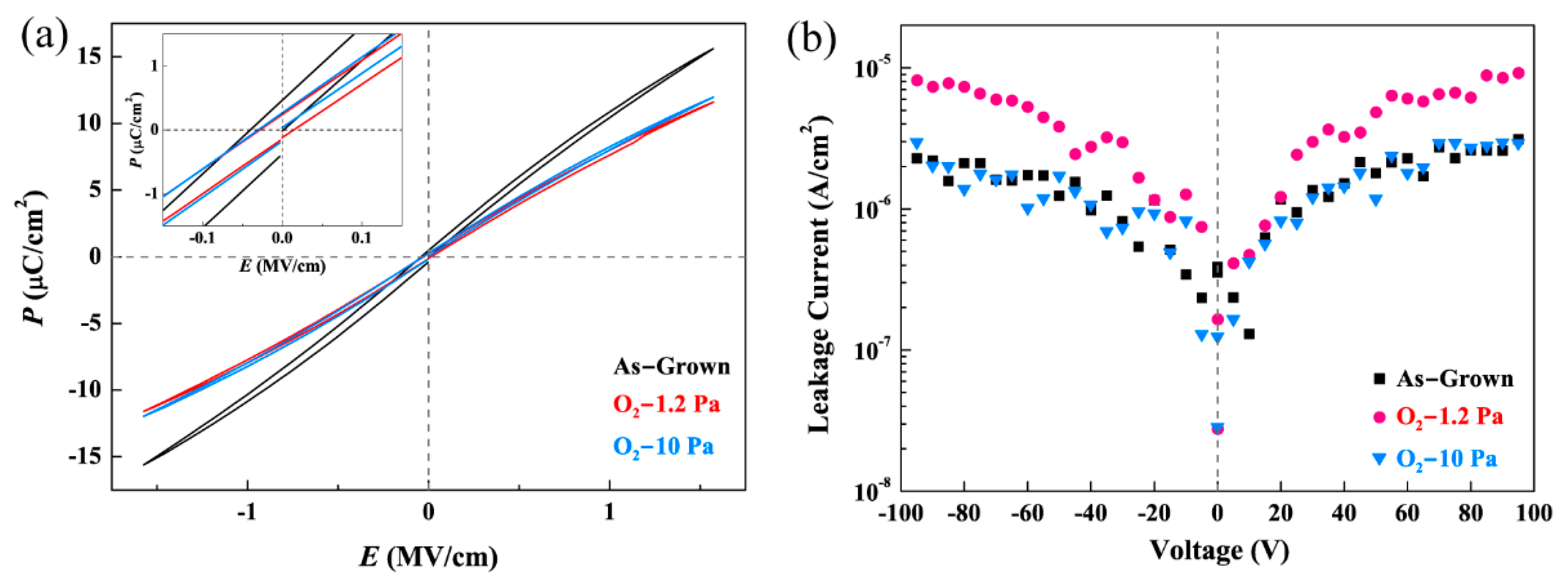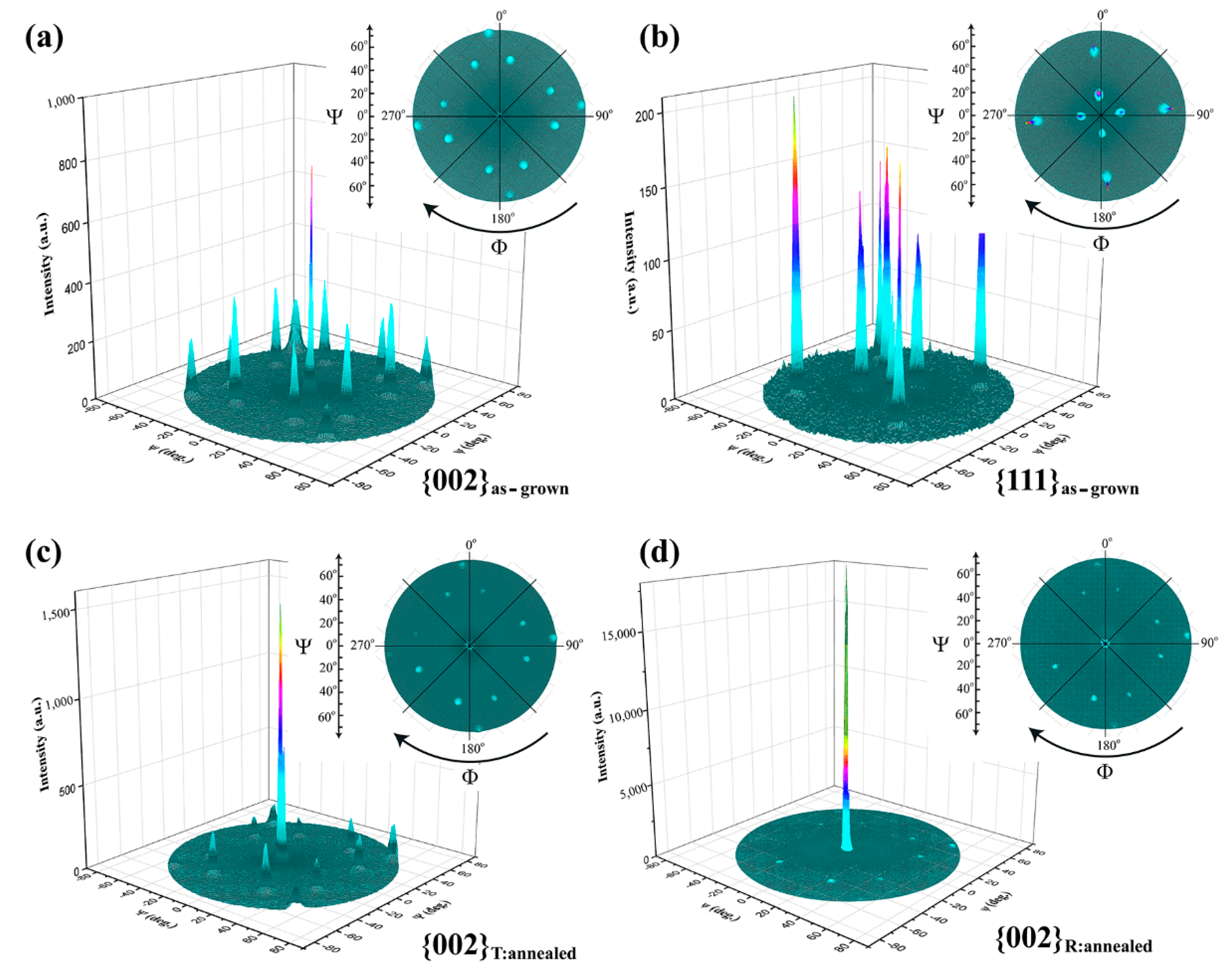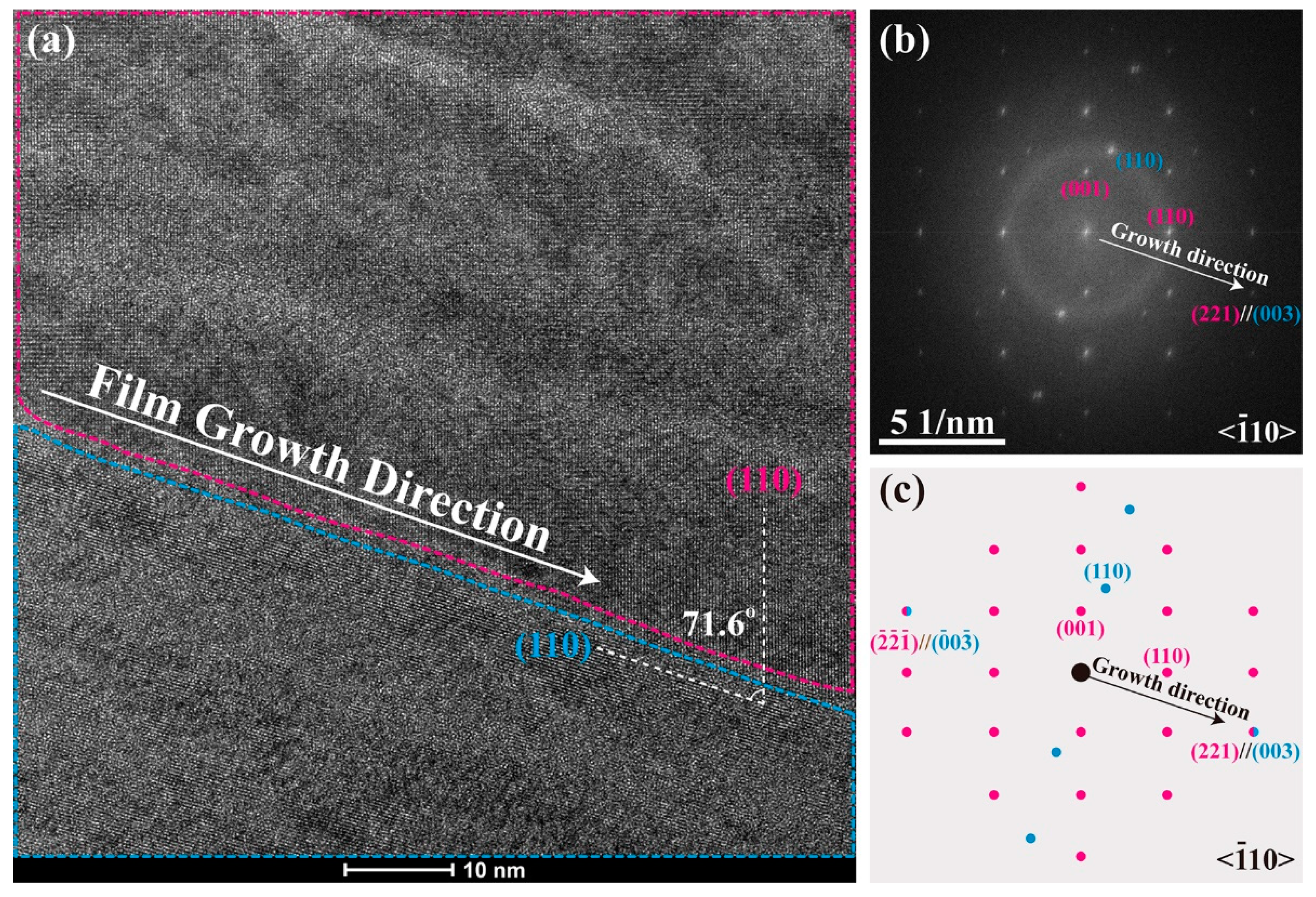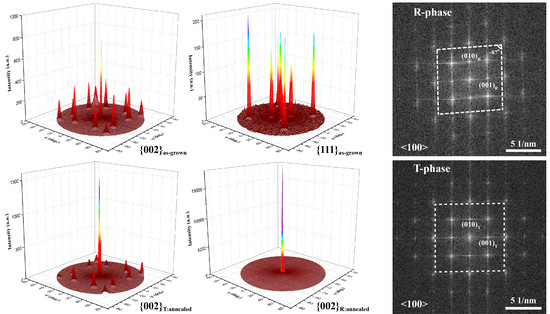Microstructural Origin of the High-Energy Storage Performance in Epitaxial Lead-Free Ba(Zr0.2Ti0.8)O3 Thick Films
Abstract
1. Introduction
2. Materials and Methods
3. Results
4. Discussions
5. Conclusions
Author Contributions
Funding
Institutional Review Board Statement
Informed Consent Statement
Data Availability Statement
Conflicts of Interest
References
- Shrout, T.R.; Zhang, S.J. Lead-free piezoelectric ceramics: Alternatives for PZT? J. Electroceramics 2007, 19, 113–126. [Google Scholar] [CrossRef]
- Saito, Y.; Takao, H.; Tani, T.; Nonoyama, T.; Takatori, K.; Homma, T.; Nagaya, T.; Nakamura, M. Lead-free piezoceramics. Nature 2004, 432, 84–87. [Google Scholar] [CrossRef] [PubMed]
- Zhou, S.; Lin, D.; Su, Y.; Zhang, L.; Liu, W. Enhanced dielectric, ferroelectric, and optical properties in rare earth elements doped PMN-PT thin films. J. Adv. Ceram. 2021, 10, 98–107. [Google Scholar] [CrossRef]
- Dash, S.; Pradhan, D.K.; Kumari, S.; Ravikant; Rahaman, M.M.; Cazorla, C.; Brajesh, K.; Kumar, A.; Thomas, R.; Rack, P.D.; et al. Enhanced ferroelectric and piezoelectric properties of BCT-BZT at the morphotropic phase boundary driven by the coexistence of phases with different symmetries. Phys. Rev. B 2021, 104, 224105. [Google Scholar] [CrossRef]
- Cui, H.; Hensleigh, R.; Yao, D.; Maurya, D.; Kumar, P.; Kang, M.G.; Priya, S.; Zheng, X.R. Three-dimensional printing of piezoelectric materials with designed anisotropy and directional response. Nat. Mater. 2019, 18, 234–241. [Google Scholar] [CrossRef]
- Liu, W.; Ren, X. Large piezoelectric effect in Pb-free ceramics. Phys. Rev. Lett. 2009, 103, 257602. [Google Scholar] [CrossRef]
- Fu, H.; Cohen, R.E. Polarization rotation mechanism for ultrahigh electromechanical response in single-crystal piezoelectrics. Nature 2000, 403, 281–283. [Google Scholar] [CrossRef] [PubMed]
- Roytburd, A.L.; Ouyang, J.; Artemev, A. Polydomain structures in ferroelectric and ferroelastic epitaxial films. J. Phys. Condens. Matter. 2017, 29, 163001. [Google Scholar] [CrossRef] [PubMed]
- Zhang, W.; Ouyang, J.; Roytburd, A.L. Effect of thickness-mediated misfit strain on the heterophase polydomain structure of epitaxial BiFeO3 films. Scr. Mater. 2012, 66, 499–502. [Google Scholar] [CrossRef]
- Kalyani, A.K.; Brajesh, K.; Senyshyn, A.; Ranjan, R. Orthorhombic-tetragonal phase coexistence and enhanced piezo-response at room temperature in Zr, Sn, and Hf modified BaTiO3. Appl. Phys. Lett. 2014, 104, 252906. [Google Scholar] [CrossRef]
- Pan, H.; Li, F.; Liu, Y.; Zhang, Q.; Wang, M.; Lan, S.; Zheng, Y.; Ma, J.; Gu, L.; Shen, Y.; et al. Ultrahigh-energy density lead-free dielectric films via polymorphic nanodomain design. Science 2019, 365, 578–582. [Google Scholar] [CrossRef] [PubMed]
- Pan, H.; Ma, J.; Ma, J.; Zhang, Q.; Liu, X.; Guan, B.; Gu, L.; Zhang, X.; Zhang, Y.-J.; Li, L.; et al. Giant energy density and high efficiency achieved in bismuth ferrite-based film capacitors via domain engineering. Nat. Commun. 2018, 9, 1813. [Google Scholar] [CrossRef] [PubMed]
- Zhang, J.X.; Xiang, B.; He, Q.; Seidel, J.; Zeches, R.J.; Yu, P.; Yang, S.Y.; Wang, C.H.; Chu, Y.H.; Martin, L.W.; et al. Large field-induced strains in a lead-free piezoelectric material. Nat. Nanotechnol. 2011, 6, 98–102. [Google Scholar] [CrossRef] [PubMed]
- Zhu, H.; Sun, X.; Kang, L.; Zhang, Y.; Yu, Z.; Ouyang, J.; Pan, W. Microstructural and electrical characteristics of epitaxial BiFeO3 thick films sputtered at different Ar/O2 flow ratios. Cryst. Eng. Comm. 2016, 18, 4604–4612. [Google Scholar] [CrossRef]
- Ouyang, J.; Zhang, W.; Huang, X.; Roytburd, A.L. Thermodynamics of formation of tetragonal and rhombohedral heterophase polydomains in epitaxial ferroelectric thin films. Acta Mater. 2011, 59, 3779–3791. [Google Scholar] [CrossRef]
- Fu, Z.; Yin, Z.G.; Chen, N.F.; Zhang, X.W.; Zhao, Y.J.; Bai, Y.M.; Chen, Y.; Wang, H.-H.; Zhang, X.L.; Wu, J.L. Tetragonal-tetragonal-monoclinic-rhombohedral transition: Strain relaxation of heavily compressed BiFeO3 epitaxial thin films. Appl. Phys. Lett. 2014, 104, 052908. [Google Scholar] [CrossRef]
- Zeches, R.J.; Rossell, M.D.; Zhang, J.X.; Hatt, A.J.; He, Q.; Yang, C.H.; Kumar, A.; Wang, C.H.; Melville, A.; Adamo, C.; et al. A strain-driven morphotropic phase boundary in BiFeO3. Science 2009, 326, 977–980. [Google Scholar] [CrossRef]
- Kawahara, Y.; Ujimoto, K.; Yoshimura, T.; Fujimura, N. Control of Crystal Structure of BiFeO3 Epitaxial Thin Films by Adjusting Growth Conditions and Piezoelectric Properties. Jpn. J. Appl. Phys. 2012, 51, 09LB04. [Google Scholar] [CrossRef]
- Kobayashi, S.; Inoue, K.; Kato, T.; Ikuhara, Y.; Yamamoto, T. Multiphase nanodomains in a strained BaTiO3 film on a GdScO3 substrate. J. Appl. Phys. 2018, 123, 064102. [Google Scholar] [CrossRef]
- Sheng, G.; Zhang, J.X.; Li, Y.L.; Choudhury, S.; Jia, Q.X.; Liu, Z.K.; Chen, L.Q. Misfit strain–misfit strain diagram of epitaxial BaTiO3 thin films: Thermodynamic calculations and phase-field simulations. Appl. Phys. Lett. 2008, 93, 23290. [Google Scholar] [CrossRef]
- Peng, W.; Zorn, J.A.; Mun, J.; Sheeraz, M.; Roh, C.J.; Pan, J.; Wang, B.; Guo, K.; Ahn, C.W.; Zhang, Y.; et al. Constructing Polymorphic Nanodomains in BaTiO3 Films via Epitaxial Symmetry Engineering. Adv. Funct. Mater. 2020, 30, 1910569. [Google Scholar] [CrossRef]
- Yokoyama, S.; Honda, Y.; Morioka, H.; Oikawa, T.; Funakubo, H.; Iijima, T.; Matsuda, H.; Saito, K. Large piezoelectric response in (111)-oriented epitaxial Pb(Zr,Ti)O3 films consisting of mixed phases with rhombohedral and tetragonal symmetry. Appl. Phys. Lett. 2003, 83, 2408–2410. [Google Scholar] [CrossRef]
- Li, F.; Lin, D.; Chen, Z.; Cheng, Z.; Wang, J.; Li, C.; Xu, Z.; Huang, Q.; Liao, X.; Chen, L.-Q.; et al. Ultrahigh piezoelectricity in ferroelectric ceramics by design. Nat. Mater. 2018, 17, 349–354. [Google Scholar] [CrossRef]
- Cheng, H.; Ouyang, J.; Zhang, Y.X.; Ascienzo, D.; Li, Y.; Zhao, Y.Y.; Ren, Y. Demonstration of ultra-high recyclable energy densities in domain-engineered ferroelectric films. Nat. Commun. 2017, 8, 1999. [Google Scholar] [CrossRef]
- Dong, L.; Stone, D.S.; Lakes, R.S. Enhanced dielectric and piezoelectric properties of xBaZrO3-(1−x)BaTiO3 ceramics. J. Appl. Phys. 2012, 111, 084107. [Google Scholar] [CrossRef]
- Wang, J.-J.; Su, Y.-J.; Wang, B.; Ouyang, J.; Ren, Y.-H.; Chen, L.-Q. Strain engineering of dischargeable energy density of ferroelectric thin-film capacitors. Nano Energy 2020, 72, 104665. [Google Scholar] [CrossRef]
- Ren, Y.; Cheng, H.; Ouyang, J.; Kurt, O.; Wang, J.; Zhang, Q.; Zhao, Y.; Gu, L.; Chen, L.-Q. Bimodal polymorphic nanodomains in ferroelectric films for giant energy storage. Energy Storage Mater. 2022, 48, 306–313. [Google Scholar] [CrossRef]
- Wang, Y.; Yan, J.; Cheng, H.; Chen, N.; Yan, P.; Ouyang, J. Low thermal budget lead zirconate titanate thick films integrated on Si for piezo-MEMS applications. Microelectron. Eng. 2020, 219, 111145. [Google Scholar] [CrossRef]
- Nagarajan, V.; Roytburd, A.; Stanishevsky, A.; Prasertchoung, S.; Zhao, T.; Chen, L.; Melngailis, J.; Auciello, O.; Ramesh, R. Dynamics of ferroelastic domains in ferroelectric thin films. Nat. Mater. 2003, 2, 43–47. [Google Scholar] [CrossRef]
- Ren, Y.; Kurt, O.; Cheng, H.; Le, T.; Greenbaum, S.; Ouyang, J. Electrical Field Driven Structural Evolutions of Polymorphic Nanodomains in Ferroelectric Ba(Zr,Ti)O3 Films. Adv. Electron. Mater. 2022, 2200465. [Google Scholar] [CrossRef]





Publisher’s Note: MDPI stays neutral with regard to jurisdictional claims in published maps and institutional affiliations. |
© 2022 by the authors. Licensee MDPI, Basel, Switzerland. This article is an open access article distributed under the terms and conditions of the Creative Commons Attribution (CC BY) license (https://creativecommons.org/licenses/by/4.0/).
Share and Cite
Ouyang, J.; Wang, X.; Shao, C.; Cheng, H.; Zhu, H.; Ren, Y. Microstructural Origin of the High-Energy Storage Performance in Epitaxial Lead-Free Ba(Zr0.2Ti0.8)O3 Thick Films. Materials 2022, 15, 6778. https://doi.org/10.3390/ma15196778
Ouyang J, Wang X, Shao C, Cheng H, Zhu H, Ren Y. Microstructural Origin of the High-Energy Storage Performance in Epitaxial Lead-Free Ba(Zr0.2Ti0.8)O3 Thick Films. Materials. 2022; 15(19):6778. https://doi.org/10.3390/ma15196778
Chicago/Turabian StyleOuyang, Jun, Xianke Wang, Changtao Shao, Hongbo Cheng, Hanfei Zhu, and Yuhang Ren. 2022. "Microstructural Origin of the High-Energy Storage Performance in Epitaxial Lead-Free Ba(Zr0.2Ti0.8)O3 Thick Films" Materials 15, no. 19: 6778. https://doi.org/10.3390/ma15196778
APA StyleOuyang, J., Wang, X., Shao, C., Cheng, H., Zhu, H., & Ren, Y. (2022). Microstructural Origin of the High-Energy Storage Performance in Epitaxial Lead-Free Ba(Zr0.2Ti0.8)O3 Thick Films. Materials, 15(19), 6778. https://doi.org/10.3390/ma15196778








